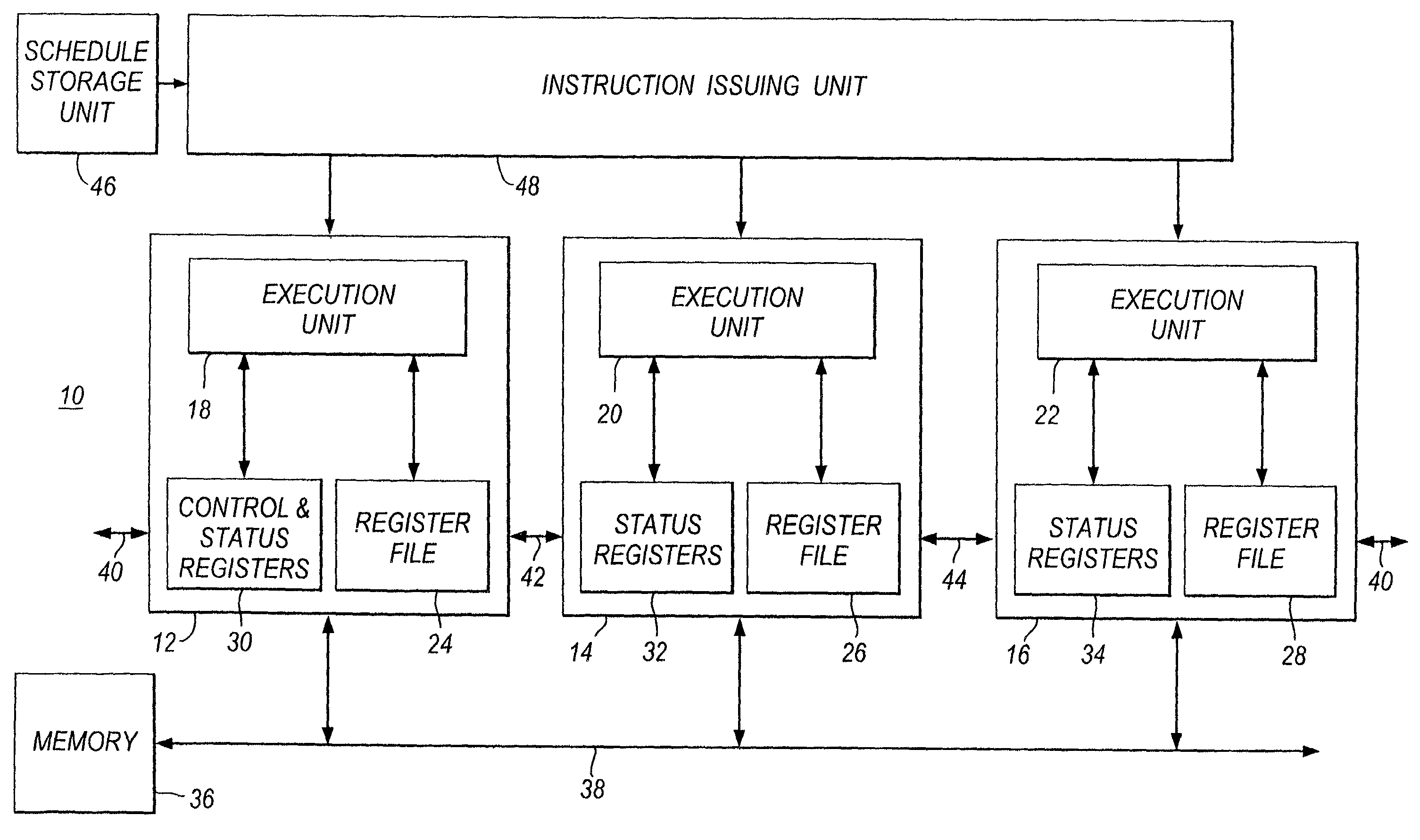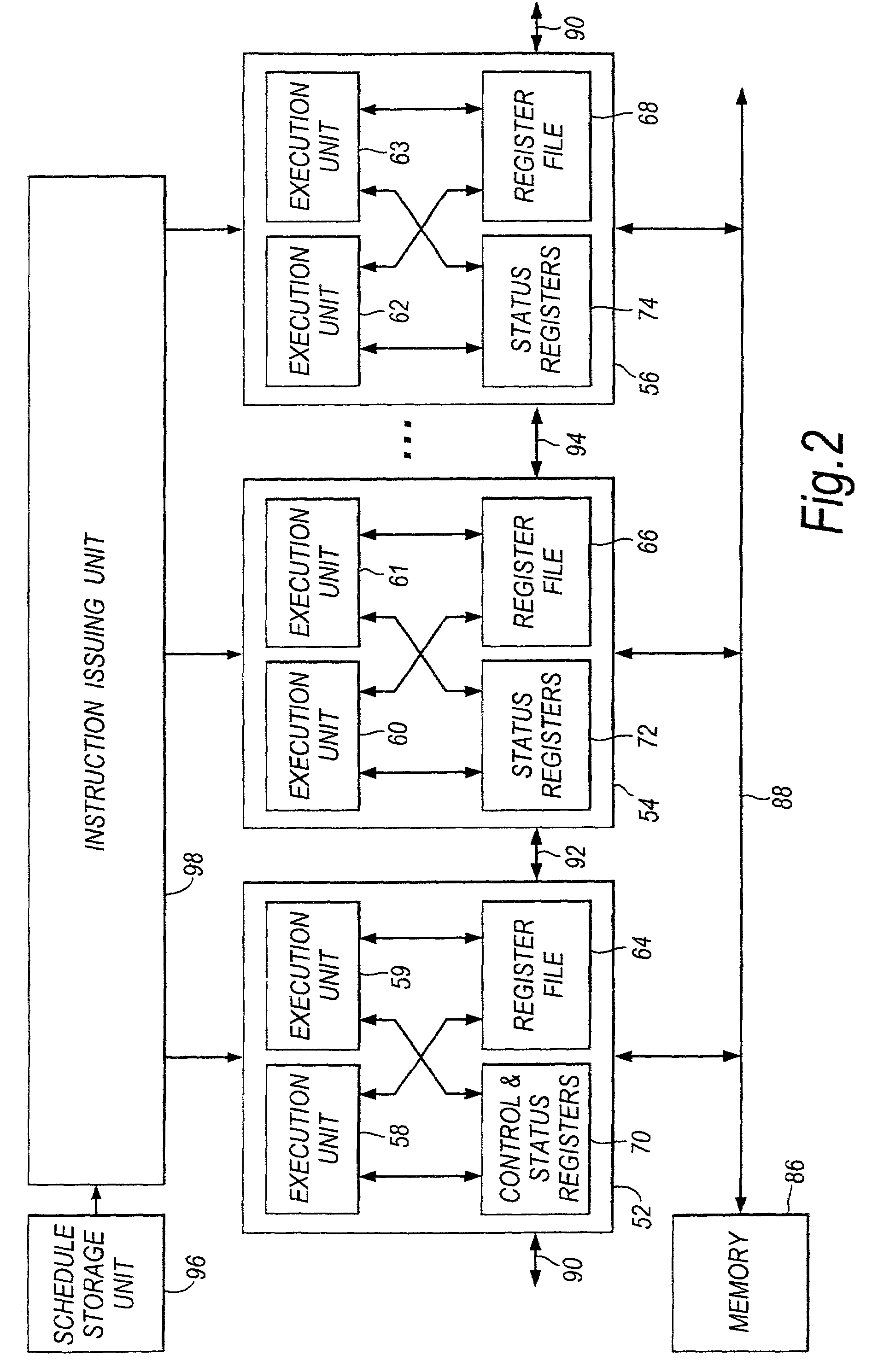Context preservation
a technology of context preservation and processing, applied in the field of processors, can solve the problems of consuming an undesirably large amount of processor time, reducing the rate at which tasks can be processed, and unnecessarily preserving and restoring parts of the processor context, so as to improve the overall system performan
- Summary
- Abstract
- Description
- Claims
- Application Information
AI Technical Summary
Benefits of technology
Problems solved by technology
Method used
Image
Examples
first embodiment
[0068]In a first embodiment, all threads which run on the processor are able to enter VLIW mode. When a thread attempts to enter VLIW mode (by means of a mode transition method) an exception is generated, and the exception is handled by the operating system. As part of the exception handling, the VLIW context of the last thread to use VLIW mode is preserved, if necessary.
[0069]Operation of the first embodiment will now be described with reference to FIGS. 6 and 7. FIG. 6 shows the steps taken by the exception handling routine when an exception is generated by a thread attempting to enter VLIW mode, and FIG. 7 shows the steps taken by the operating system when a context switch occurs. In this embodiment, a transition from VLIW mode to scalar mode may or may not cause an exception to be generated, depending on the chosen implementation.
[0070]Referring to FIG. 6, in step 100 an exception is generated by a thread which is in user mode attempting to execute a mode transition method that ...
second embodiment
[0080]In a second embodiment of the invention, only certain threads are allowed access to VLIW mode, and all other threads are barred from entering VLIW mode. In one example, only one thread is ever allowed access to VLIW mode. This may be either a thread in supervisor mode, or a thread in user mode. In another example a certain number of specified threads are allowed access to VLIW mode. By limiting the number of threads which are allowed access to VLIW mode, the number of VLIW context switches that must be made can be limited, or the need to make VLIW context switches can be eliminated.
[0081]Operation of the second embodiment will now be described with reference to FIGS. 9 and 10. FIG. 9 shows the steps taken by the exception handling routine when an exception is generated by a thread attempting to enter VLIW mode, and FIG. 10 shows the steps taken by the operating system when a context switch occurs. In FIGS. 9 and 10 it is assumed that only one predetermined thread is ever allow...
third embodiment
[0086]In a third embodiment of the invention the operating system only allows one thread (or a certain number of threads) to operate in VLIW mode at any one time. This technique can be viewed as a “token passing” technique, in which a token can be passed from thread to thread, but only the thread which has the token can enter VLIW mode. This technique can reduce the number of times that the processor's VLIW context must be preserved and restored.
[0087]Operation of the third embodiment will now be described with reference to FIGS. 11 and 12. FIG. 11 shows the steps taken by the exception handling routine when an exception is generated by a thread attempting to enter VLIW mode, and FIG. 12 shows the steps taken by the operating system when an exception is generated by a thread returning to scalar mode from VLIW mode. In this embodiment, the steps taken when a context switch occurs are the same as those shown in FIG. 10.
[0088]Referring to FIG. 11, in step 200 an exception is generated ...
PUM
 Login to View More
Login to View More Abstract
Description
Claims
Application Information
 Login to View More
Login to View More - R&D
- Intellectual Property
- Life Sciences
- Materials
- Tech Scout
- Unparalleled Data Quality
- Higher Quality Content
- 60% Fewer Hallucinations
Browse by: Latest US Patents, China's latest patents, Technical Efficacy Thesaurus, Application Domain, Technology Topic, Popular Technical Reports.
© 2025 PatSnap. All rights reserved.Legal|Privacy policy|Modern Slavery Act Transparency Statement|Sitemap|About US| Contact US: help@patsnap.com



